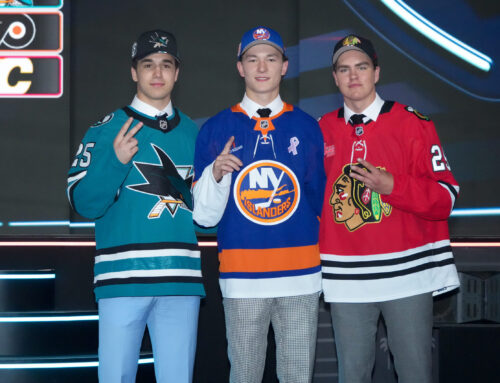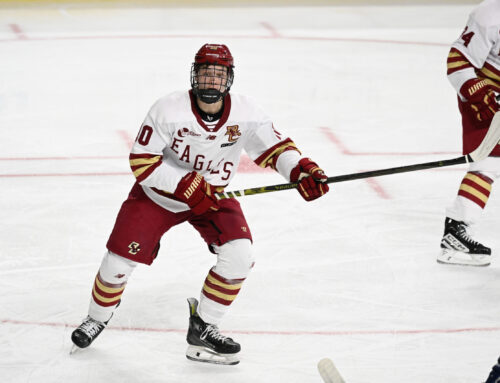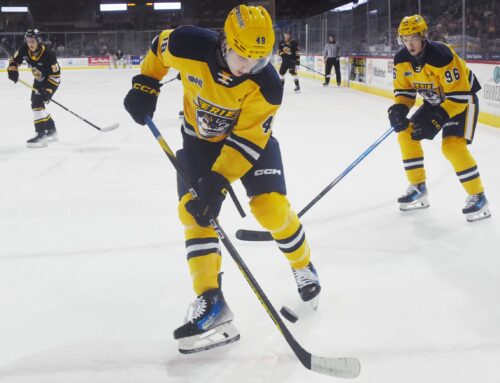Welcome back to The Journey, where we track the development of prospects as they excel in junior, make the NHL, and push towards stardom.
***
Inspired by Thomas Harley's incredible break out campaign in 2023-24—more on that in a moment—this will be the first in a series highlighting young players (under 24) around the league who made a significant mark on their respective teams this year, especially in terms of playdriving (relCorsiFor), playmaking/involvement (IPP), and overall value added (xWAR, xGAR).
This week, we will look at the league's first ten teams by alphabetical order.
At a Glance
Anaheim: Leo Carlsson, 19
Arizona: Barrett Hayton, 23
Boston: Matthew Poitras, 20 (Honorable Mention: Justin Brazeau, 26)
Buffalo: JJ Peterka, 22
Carolina: Seth Jarvis, 22
Columbus: Yegor Chinakhov, 23 (Honorable Mention: Alexander Nylander, 26)
Calgary: Connor Zary, 22 (HM: Daniil Miromanov, 26)
Chicago: Kevin Korchinski, 19
Colorado: None
Dallas: Thomas Harley, 22
***
All nine players are already important pieces for their respective teams and exciting owns in fantasy. Let's do some quick hits before diving deeper into two of them.
Although Leo Carlsson (ANA) was restricted to 55 games, he was one of the league's top-performing rookies in 2023-24, and his underlying numbers look strong, sustainable, and capable of further growth.
I had expected Barrett Hayton (ARI) to break out offensively this year but he instead declined quite dramatically before going down with an injury in early March. That continued lack of offensive punch combined with his increasing face-off prowess and effective two-way play makes him look more like a third-string C and lower-end fantasy option moving forward.
Matthew Poitras (BOS) improbably cracked the Bruins out of camp as a 19-year-old, then turned in a solid rookie year that ended in shoulder surgery in February. He was given a lot of sheltered, offensively advantageous deployment this year and did okay with it. He has lots to learn but is looking like a solid middle-six piece for Boston.
JJ Peterka (BUF) is on the verge of becoming a high-end fantasy asset. He just turned in a very strong 50-point season at age 22 and should be a lock for 30+ goals moving forward.
Seth Jarvis (CAR) scored nearly 70 points this year at 22 years old and added more Wins Against Replacement (xWAR) than Sebastian Aho, Andrei Svechnikov, and Jake Guentzel combined. He is already a top-line, two-way force who is learning the ropes alongside one of the league's top defensive forwards (Jordan Staal).
Yegor Chinakhov (CBJ) has quietly improved his scoring pace every year since 2021-22 and finished 13th overall in Expected Goals Against Replacement (xGAR) amongst U23 players in 2023-24. While he might get squeezed out of Columbus' top six as this team improves, there is a chance he sticks and excels, especially given his chemistry with fellow young Blue Jackets Dmitry Voronkov and Kirill Marchenko.
Connor Zary (CGY) became one of Calgary's most consistent and dangerous scorers this year. Though often on the second unit, he saw a healthy amount of power play time and seems to have established himself as an important part of their top six moving forward.
The concerns around Kevin Korchinski (CHI) at the 2022 draft largely revolved around whether he could hold his own defensively and adjust his freewheeling offensive style to the more structured NHL game. While 15 points doesn't move the fantasy needle just yet and the Blackhawks basically got blown up all year, he did hold his own, relatively speaking, with sheltered deployment and proved that his power play prowess could be replicated at the game's highest level.
I might have to reevaluate how I value blueline prospects in fantasy. In recent years, I've whiffed on high-offence defenders like Erik Brannstrom, Ty Smith, and Ryan Merkley, and I went into this past fantasy season thinking that even if Thomas Harley (DAL) stuck with the Stars, he was not likely to do anything much. His production at lower levels was never anything that special, and it seemed unlikely that he would improve offensively against harder competition.
Boy, was I wrong. Let's dig in further on him.
***
Kind of like Brock Faber in Minnesota (who also finished with 47 points), Harley did not start receiving meaningful PP minutes until a quarter of the way through the season. When Miro Heiskanen went down with an injury in early January, Harley's average time on ice went up by four minutes and stayed there. He scored 42 points over his final 62 games, a 56-point pace, and looks set to build on that in 2024-25.
Heiskanen and Harley have become a dominant puck-moving duo at even strength. As a kid, the one thing I learned playing the NHL franchise on my computer every year from 1998 onwards was that you always paired offensive defenders with stay-at-home guys. That was the blueprint. Well, in 2024, Heiskanen and Harley are very effectively bucking that trope, playing big, impactful minutes together on the Stars' back end as a couple smart, ultra-mobile, offensively inclined defenseman.
Here is Dallas' deployment chart. Just look at those big, twin, dark blue circles on the right side. Harley was appropriately more sheltered than Heiskanen, one of the league's top defencemen, but he definitively proved that he can handle and excel with harder minutes.

Harley's inexperience relative to Heiskanen shows up in little ways. He is a lot worse at drawing penalties versus taking them, for instance, at which Heiskanen is a master. There is lots of room for growth with him on the power play too. That may continue to be a factor holding down his ultimate fantasy potential, but talent usually finds a way.
Here are the Stars' top players ranked by xGAR, a stat which includes both offensive and defensive impact:
Roope Hintz: 26.8
Thomas Harley: 21.8
Jason Robertson: 21.1
Miro Heiskanen: 20.6
Mason Marchment: 13.3
Wyatt Johnston: 12.8
Jamie Benn: 12.3
Esa Lindell: 11.7
Tyler Seguin: 9.8
Stunning results from a 22-year-old defenseman. If Harley had played 10 games fewer in 2021-22 and one game fewer the following year, he could have been garnering pretty serious consideration for this year's Calder Trophy.
***
Although the Sabres' many first-round picks take up much of the limelight in Buffalo, JJ Peterka (34th overall in 2020) just turned in a campaign that most of the team's other high-octane forward prospects have yet to match. Given about three more minutes of ice time per game this year versus last, Peterka upped his shot rate dramatically (1.6 → 2.8), bested the 50-point barrier, and scored nearly 30 goals while retaining a sustainable-looking shooting percentage.
He now sits at 161 games played in his NHL career and is on track to break out just as Buffalo starts to get going in earnest. If Tage Thompson can rediscover his form, a healthy Jack Quinn takes a step forward, and so on, this is a team that will score a ton of goals. Expect Peterka to be right in the middle of the action.
His underlying metrics look very sustainable. He is driving play well relative to his teammates without needing to be excessively sheltered. He is involved in a healthy amount of the scoring that happens while he is on the ice.
Like Harley, Peterka finished second on his team in xGAR:
Rasmus Dahlin: 20.7
JJ Peterka: 14.5
Tage Thompson: 9.6
Casey Mittelstadt: 5.7
Alex Tuch: 5.4
Jacob Bryson: 3.8
Kyle Okposo: 3.8
Zach Benson: 3.2
Jack Quinn: 2.9
The drop off in value added after Thompson reveals how much weaker Buffalo was this year than Dallas, but Peterka was a major driving force for this team—and he would have been the third-most-impactful forward on the Stars. As support arrives, his offence will more than likely swell to even greater heights.
My prediction for him next year: 35 goals and 65 points.
***
Thanks for reading! Follow me on X @beegare for more prospect content and fantasy hockey analysis.





 EDM
EDM TOR
TOR PIT
PIT VAN
VAN FLA
FLA MIN
MIN DET
DET COL
COL
